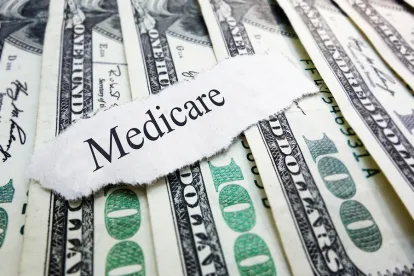The Medicare Board of Trustees is calling for urgent legislative action to address the impending financial insolvency of the Medicare hospital benefit program. The Board’s 2016 report reveals the trust fund that pays for hospital services under Medicare Part A will be depleted by year 2028. At that time, the report indicates Medicare revenue will cover only 87% of payments for anticipated hospital benefits. Although the Trustees have projected inadequate Medicare financing in the past, this year’s insolvency projection comes in two years earlier than last year’s report.
Medicare Costs Outpace Program Revenue, the Economy
Total Medicare expenditures reached $648 billion in 2015, or 3.6% of GDP. Despite cost-reduction measures in the Medicare Access and CHIP Reauthorization Act of 2015 (MACRA) and Affordable Care Act (ACA), the Medicare Board of Trustees projects program costs as a percentage of GDP will rise to 5.6% in 2040 and 6% in 2090.
Although per-enrollee spending growth through year 2090 is relatively low at 3.8%, Medicare costs will certainly outpace revenue as enrollment expands to serve the growing aging population.
Part A Funding Fails Short-Run Financial Adequacy and Long-Run Sustainability Tests
The Medicare Board of Trustees oversees the financial operations of the two trust funds that pay for Medicare benefits: the Hospital Insurance Trust Fund (HI) and the Supplementary Medical Insurance Trust Fund (SMI). HI, which pays for Medicare Part A (hospital inpatient services), is funded primarily through payroll taxes. SMI pays for Medicare Part B (physician services) and Medicare Part D (prescription drug coverage) through general federal revenue and contributions from premium payments.
The HI trust fund has not demonstrated short-range financial adequacy since 2003. While the Trustees recommend a minimum level of assets to cover 100% of expenditures, in 2015, HI assets ($197.3 billion) represented only 73% of expenditures. The Board projects that program costs will continue to exceed income, as it has every year since 2008.
HI trust fund depletion is now projected for year 2028, meaning that Medicare funding for Part A will be limited to ongoing tax revenues. Without legislative intervention, operating on tax revenues alone will cover only 87% of Part A expenditures in 2028, and 80% by 2050. Part A benefits include hospital inpatient, home health, skilled nursing facility, and hospice services.
This year’s insolvency projection comes in two years earlier than previous estimates based on adjustments for lower payroll tax income and higher program expenditures. The Board attributes rising medical costs to slower-than-expected decreases in inpatient utilization and the high costs of specialty drugs.
Medicare Parts B and D Escape Insolvency, Face Rising Expenditures
SMI is inherently safe from financial insolvency, as funding from general federal revenue and beneficiary premiums is automatically reset each year to cover anticipated spending. Still, almost one-third of Part B beneficiaries will likely experience a substantial increase in premium costs to adjust for rising program expenditure.
The report projects annual cost growths for Parts B and D at 6.9% and 10.6% over the next five years, respectively. In comparison, the economy is expected to grow at a rate of only 5%. Program funding must therefore increase at a faster rate than GDP to account for rising costs.
The Trustees estimate that monthly Part B premiums will increase 23% in 2017 to adjust for costs, from $121.80 to $149.00. While the majority of Part B beneficiaries will avoid the increase due to a “hold harmless” policy that restricts premiums from outpacing changes to cost-of-living, general federal funds must be transferred to cover the difference. About 70% of beneficiaries pay Part B premiums through deductions on Social Security payments, which cannot increase according to the policy. Beneficiaries that are not protected include those newly enrolled in Medicare and individuals who are dually eligible for Medicaid.
Despite expected increases in general revenue transfers to cover those protected under the hold harmless provision, the Trustees do not anticipate excess general revenue funding; through year 2022, general revenue is not expected to reach 45% of total Medicare costs, the established threshold for an “unduly large” impact on the federal budget.
What are the Solutions?
Effective legislation is essential—according to the Board, implementation of the ACA extended Medicare solvency by 11 years. The report also warns that if cost-reduction measures in MACRA and the ACA are eroded or new legislation scales them back, Medicare costs will increase from 6% of GDP to 9.1% in 2090.
To ensure HI trust fund solvency and reduce expenditures, legislation must either raise the Social Security payroll tax rate, cut benefits, or both.
Other policy alternatives include expansion of cost-reduction measures. Section 3021 of the ACA established the Center for Medicaid and Medicare Innovation to develop and test innovative health care payment and service delivery models. The Innovation Center is currently testing models across the U.S. that reward value-based care and possibly lower program costs.
Both the public and lawmakers have also demonstrated widespread support for legislation that allows Medicare to negotiate drug prices.
The Trustees recommend that Congress and the Executive Branch work together to pass legislation, emphasizing that earlier action “increases the time available for affected individuals and organizations—including health care providers, beneficiaries, and taxpayers—to adjust their expectations and behavior.”



 />i
/>i
